snow chains Hyundai Matrix 2005 Owner's Manual
[x] Cancel search | Manufacturer: HYUNDAI, Model Year: 2005, Model line: Matrix, Model: Hyundai Matrix 2005Pages: 407, PDF Size: 10.31 MB
Page 82 of 407

DRIVING YOUR HYUNDAI
2- 10 C300B01O-GAT TCS ON ModeIn the TCS ON mode, the indicator in the instrument cluster will not be illuminated. NOTE:
1) Turn off the engine. Then restart the
engine, and the TCS mode will auto- matically turn "ON".
2) When the traction control is operating properly, you can feel a slight pulsationin the vehicle. This is only the effect of brake control and indicates nothing unusual.
Driving hints TCS does not actively apply brakes. Be sure to decelerate the car sufficiently before enter- ing curves. CAUTION: When the TCS indicator blinks, SLIP con-trol has been activated. It also means that the road is slippery or your car is acceler- ating excessively. In this situation, release foot pressure from the accelerator pedal and maintain moderate speed. WARNING: Traction control is only a driving aid; all normal precautions for driving in inclem- ent weather and on slippery driving sur- faces should be observed.
The braking distance for cars equipped
with an anti-lock braking system may belonger than for those without it, in the following road conditions.
o Driving on rough, gravel or snow-cov-
ered roads.
o Driving with tyre chains installed.
o Driving on roads where the road sur- face is pitted or has different surfaceheight.
These roads should be driven at reduced
speeds. The safety features of an ABSequipped vehicle should not be tested by high speed driving or cornering. This could endanger the safety of yourself or others. C300A01O-EAT
BRAKE TRACTION CONTROL SYSTEM (BTCS) (Not all models)
On slippery road surfaces, the traction control system (TCS) limits the drive wheels from spinning excessively, thus helping the car to accelerate. It also provides sufficient driving force and steering performance as the car turns at accelerated speeds.
SLIP Control Limits the drive wheels from spinning exces-sively during starting or whilst making accel- erated turns on slippery roads to avoid losing the driving force of the front wheels.
o Do not hold the vehicle on the upgrade with
the accelerator pedal. This can cause the transmission to overheat. Always use the brake pedal or parking brake.
SC140B1-E ANTI-LOCK BRAKE SYSTEM (Not all models) The Anti-Lock Brake System (ABS) is de- signed to prevent wheel lock-up during sud- den braking or on hazardous road surfaces. The ABS control module monitors the wheel speed and controls the pressure applied to each brake. Thus, in emergency situations or on slick roads, ABS will increase vehicle con- trol during braking. NOTE: During ABS operation, a slight pulsation may be felt in the brake pedal when the brakes are applied. Also, a noise may be heard in the engine compartment whilst braking. These conditions are normal and indicate that the anti-lock brake system is functioning properly. WARNING: ABS will not prevent accidents due to im-proper or dangerous driving maneuvers. Even though vehicle control is improved during emergency braking, always maintain a safe distance between you and objects ahead. Vehicle speeds should always be reduced during extreme road conditions.
Page 91 of 407
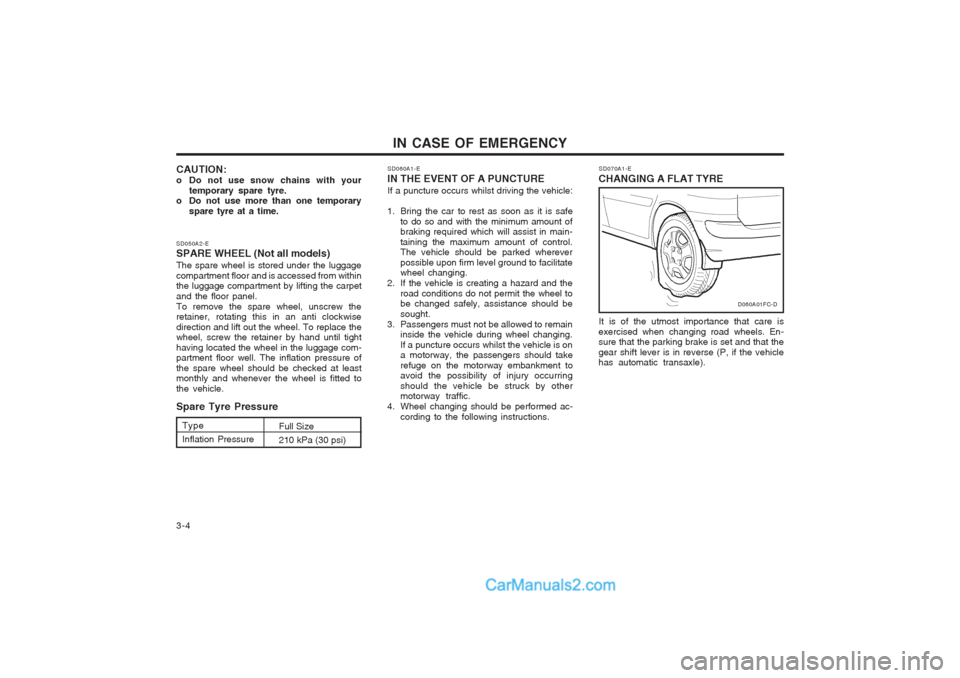
IN CASE OF EMERGENCY
3-4
SD070A1-E
CHANGING A FLAT TYRE
It is of the utmost importance that care is
exercised when changing road wheels. En- sure that the parking brake is set and that the gear shift lever is in reverse (P, if the vehicle has automatic transaxle).
D060A01FC-D
SD050A2-E SPARE WHEEL (Not all models) The spare wheel is stored under the luggage compartment floor and is accessed from within the luggage compartment by lifting the carpet and the floor panel.To remove the spare wheel, unscrew the retainer, rotating this in an anti clockwise direction and lift out the wheel. To replace the wheel, screw the retainer by hand until tight having located the wheel in the luggage com- partment floor well. The inflation pressure of the spare wheel should be checked at least monthly and whenever the wheel is fitted to the vehicle. Spare Tyre Pressure
CAUTION:
o Do not use snow chains with your
temporary spare tyre.
o Do not use more than one temporary
spare tyre at a time. SD060A1-E
IN THE EVENT OF A PUNCTURE If a puncture occurs whilst driving the vehicle:
1. Bring the car to rest as soon as it is safe to do so and with the minimum amount of braking required which will assist in main- taining the maximum amount of control. The vehicle should be parked wherever possible upon firm level ground to facilitate wheel changing.
2. If the vehicle is creating a hazard and the road conditions do not permit the wheel tobe changed safely, assistance should be sought.
3. Passengers must not be allowed to remain inside the vehicle during wheel changing.If a puncture occurs whilst the vehicle is on a motorway, the passengers should take refuge on the motorway embankment to avoid the possibility of injury occurring should the vehicle be struck by other motorway traffic.
4. Wheel changing should be performed ac- cording to the following instructions.
Type Inflation Pressure Full Size210 kPa (30 psi)
Page 142 of 407

CONSUMER INFORMATION
8-2 NOTE:
o Do not use the temporary spare tyre for tyre rotation.
o Aluminium wheels which are not sup- plied as Original Equipment should not be mixed on the same vehicle withthe original steel wheels. However, it isacceptable that the steel spare wheelbe used in conjunction with OriginalEquipment aluminium wheels since theoffset of both wheels is compatible.Radial and cross ply tyres should notbe mixed on the same vehicle.
I060A01FC-EAT
TYRE ROTATION
The tyre wear characteristics will vary be-
tween each tyre dependant upon the condi-tions of use. It is normal for the front tyres towear more rapidly than those fitted to the rearof the vehicle and therefore tyre rotation willprovide a means of helping to ensure an evenwear rate across the tyre set. For vehiclesfitted with radial ply tyres, rotation should beconfined to front to rear tyre alternation. It isnot recommended that radial ply tyres berotated from side to side. SI060A1-E
TYRE BALANCING Incorrect tyre balance will cause steering
vibration and uneven tyre wear. The vehicletyres are balanced during production but mayneed further balancing throughout the life ofthe tyres.
It is recommended that the tyres be balanced
on the car for best results and that the tyres arebalanced whenever they have been removedfrom the wheel for repair.
SI030A2-E
SNOW TYRES If it is desired to fit snow tyres to the vehicle,
it must be ascertained that the original sizeand load carrying capacity are met by thereplacement tyres. When using snow tyres,the vehicle should not be driven at speeds inexcess of 60 MPH.
SI040A1-E
TYRE CHAINS
Tyre chains, when included, should be in-
stalled on the front wheels. Be sure that thechains are the proper size and that they areinstalled in accordance with themanufacturer's instructions.
To minimise tyre and chain wear, do not
continue to use tyre chains when they are nolonger needed.
CAUTION:When driving on roads covered with snow
or ice, drive at less than 20 mph (30 km/h). Tyre pressures should be increased by 3 psi
when the vehicle is driven fully laden or underconditions of sustained high speed motoring.
HA1409Spare tyre
Page 150 of 407
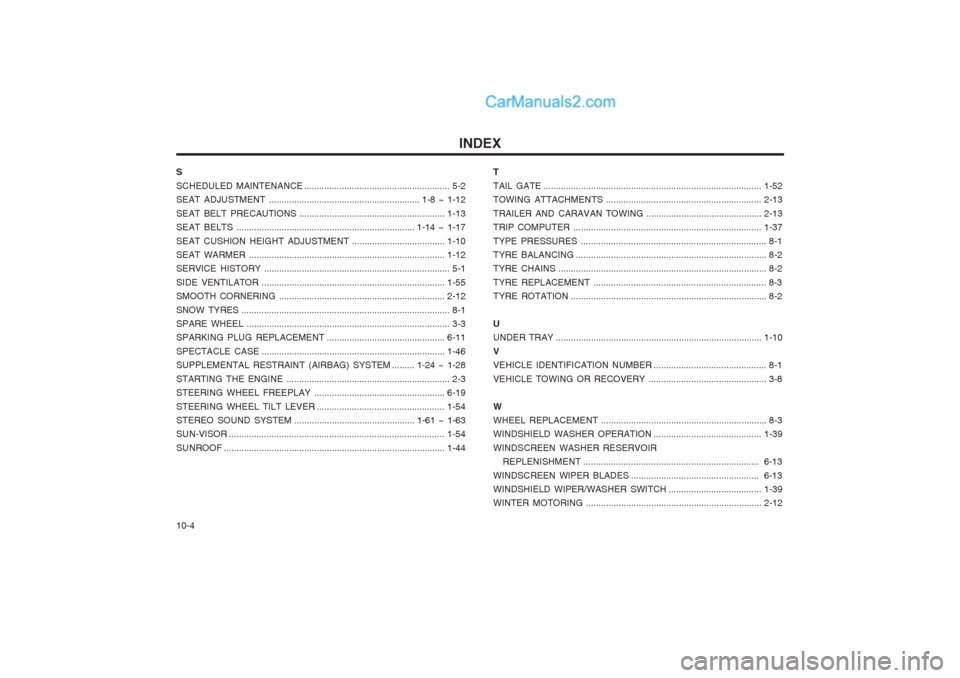
INDEX
10-4
S SCHEDULED MAINTENANCE
.......................................................... 5-2
SEAT ADJUSTMENT .. .......................................................... 1-8 ~ 1-12
SEAT BELT PRECAUTIONS .......................................................... 1-13
SEAT BELTS ....................................................................... 1-14 ~ 1-17
SEAT CUSHION HEIGHT ADJUSTMENT .....................................1-10
SEAT WARMER .............................................................................. 1-12
SERVICE HISTORY .......................................................................... 5-1
SIDE VENTILATOR ......................................................................... 1-55
SMOOTH CORNERING ............. .....................................................2-12
SNOW TYRES ................................................................................... 8-1
SPARE WHEEL ................................................................................. 3-3
SPARKING PLUG REPLACEMENT ...............................................6-11
SPECTACLE CASE ......................................................................... 1-46
SUPPLEMENTAL RESTRAINT (AIRBAG) SYSTEM ......... 1-24 ~ 1-28
STARTING THE ENGINE ................................................................. 2-3
STEERING WHEEL FREEPLAY ....................................................6-19
STEERING WHEEL TILT LEVER ...................................................1-54
STEREO SOUND SYSTEM ................................................ 1-61 ~ 1-63
SUN-VISOR ...................................................................................... 1-54
SUNROOF ........................................................................................ 1-44TTAIL GATE
....................................................................................... 1-52
TOWING ATTACHMENTS .............................................................. 2-13
TRAILER AND CARAVAN TOWING ..............................................2-13
TRIP COMPUTER ........................................................................... 1-37
TYPE PRESSURES .......................................................................... 8-1
TYRE BALANCING ............................................................................ 8-2
TYRE CHAINS ................................................................................... 8-2
TYRE REPLACEMENT ..................................................................... 8-3
TYRE ROTATION .............................................................................. 8-2
U UNDER TRAY .................................................................................. 1-10
VVEHICLE IDENTIFICATION NUMBER ............................................. 8-1
VEHICLE TOWING OR RECOVERY ............................................... 3-8
WWHEEL REPLACEMENT .................................................................. 8-3
WINDSHIELD WASHER OPERATION ...........................................1-39
WINDSCREEN WASHER RESERVOIR REPLENISHMENT ...................................................................... 6-13
WINDSCREEN WIPER BLADES ................................................... 6-13
WINDSHIELD WIPER/WASHER SWITCH .....................................1-39
WINTER MOTORING ...................................................................... 2-12
Page 303 of 407

2 DRIVING YOUR HYUNDAI
14
!
BRAKE TRACTION CONTROL SYSTEM (BTCS)
o Driving on rough, gravel or snow-
covered roads.
o Driving with tire chains installed.
o Driving on roads where the road
surface is pitted or has different surface height.
During these conditions, the ve-hicle should be driven at reduced speeds. The safety features of anABS equipped vehicle should not be tested by high speed driving or cornering. This could endanger the safety of yourself or others. C300A01O-GAT (If Installed) On slippery road surfaces, the traction control system (TCS) limits the drivewheels from spinning excessively, thus helping the car to accelerate. It also provides sufficient driving force andsteering performance as the car turns at accelerated speeds. SLIP Control Limits the drive wheels from spinning excessively during starting or whilemaking accelerated turns on slippery roads to avoid losing the driving force of the front wheels. Driving hints TCS does not actively apply brakes. Be sure to decelerate the car suffi-ciently before entering curves. CAUTION:
When the TCS indicator blinks, SLIPcontrol has been activated. It also means that the road is slippery or your car is accelerating excessively.In this situation, gently release foot pressure from the accelerator pedal and maintain moderate speed.
WARNING:
Traction control is only a driving aid; all normal precautions for driv- ing in inclement weather and onslippery driving surfaces should be observed.!
Page 307 of 407
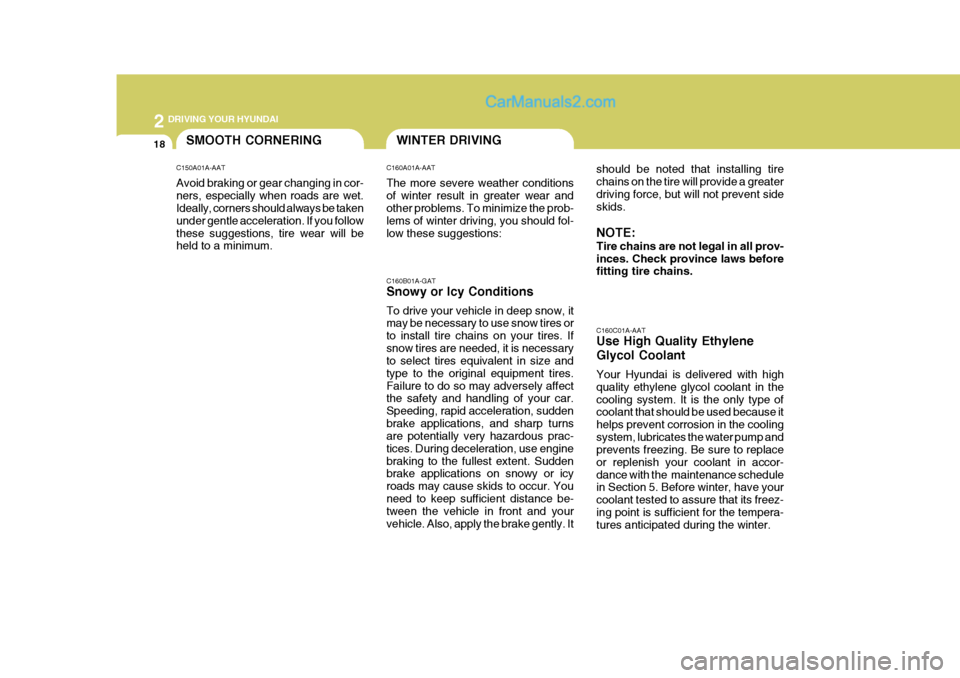
2 DRIVING YOUR HYUNDAI
18SMOOTH CORNERINGWINTER DRIVING
C160A01A-AAT The more severe weather conditions of winter result in greater wear and other problems. To minimize the prob- lems of winter driving, you should fol-low these suggestions:
C150A01A-AAT Avoid braking or gear changing in cor- ners, especially when roads are wet. Ideally, corners should always be taken under gentle acceleration. If you followthese suggestions, tire wear will be held to a minimum. should be noted that installing tire chains on the tire will provide a greaterdriving force, but will not prevent side skids. NOTE: Tire chains are not legal in all prov- inces. Check province laws before fitting tire chains.
C160B01A-GAT Snowy or Icy Conditions To drive your vehicle in deep snow, it may be necessary to use snow tires or to install tire chains on your tires. Ifsnow tires are needed, it is necessary to select tires equivalent in size and type to the original equipment tires.Failure to do so may adversely affect the safety and handling of your car. Speeding, rapid acceleration, suddenbrake applications, and sharp turns are potentially very hazardous prac- tices. During deceleration, use enginebraking to the fullest extent. Sudden brake applications on snowy or icy roads may cause skids to occur. Youneed to keep sufficient distance be- tween the vehicle in front and your vehicle. Also, apply the brake gently. It C160C01A-AAT Use High Quality Ethylene Glycol Coolant Your Hyundai is delivered with high quality ethylene glycol coolant in thecooling system. It is the only type of coolant that should be used because it helps prevent corrosion in the coolingsystem, lubricates the water pump and prevents freezing. Be sure to replace or replenish your coolant in accor-dance with the maintenance schedule in Section 5. Before winter, have your coolant tested to assure that its freez-ing point is sufficient for the tempera- tures anticipated during the winter.
Page 309 of 407

2 DRIVING YOUR HYUNDAI
20
C180A01A-AAT USE OF LIGHTS Check your lights regularly for correct operation and always keep them clean.When driving during the day in condi- tions of poor visibility, it is helpful to drive with headlights on low beam.This enables you to be seen as well as to see.
C160J01A-AAT Don't Let Ice and Snow Accumulate Underneath Under some conditions, snow and ice can build up under the fenders andinterfere with the steering. When driv- ing in severe winter conditions where this may happen, you should periodi-cally check underneath the car to be sure the movement of the front wheels and the steering components is notobstructed. C160K01A-AAT Carry Emergency Equipment Depending on the severity of the weather where you drive your car, you should carry appropriate emergency equipment. Some of the items youmay want to carry include tire chains, tow straps or chains, flashlight, emer- gency flares, sand, a shovel, jumpercables, a window scraper, gloves, ground cloth, coveralls, a blanket, etc. C170A01A-AAT HIGHER SPEED MOTORING Pre-Trip Inspections 1. Tires: Adjust the tire inflation pressures to specification. Low tire inflation pres- sures will result in overheating andpossible failure of the tires. Avoid using worn or damaged tires which may result in reduced traction ortire failure. NOTE: Never exceed the maximum tire infla- tion pressure shown on the tires. 2. Fuel, engine coolant and en- gine oil: High speed travel consumes more fuel than urban motoring. Do not forget tocheck both engine coolant and engine oil. 3. Drive belt: A loose or damaged drive belt may result in overheating of the engine.
Page 319 of 407
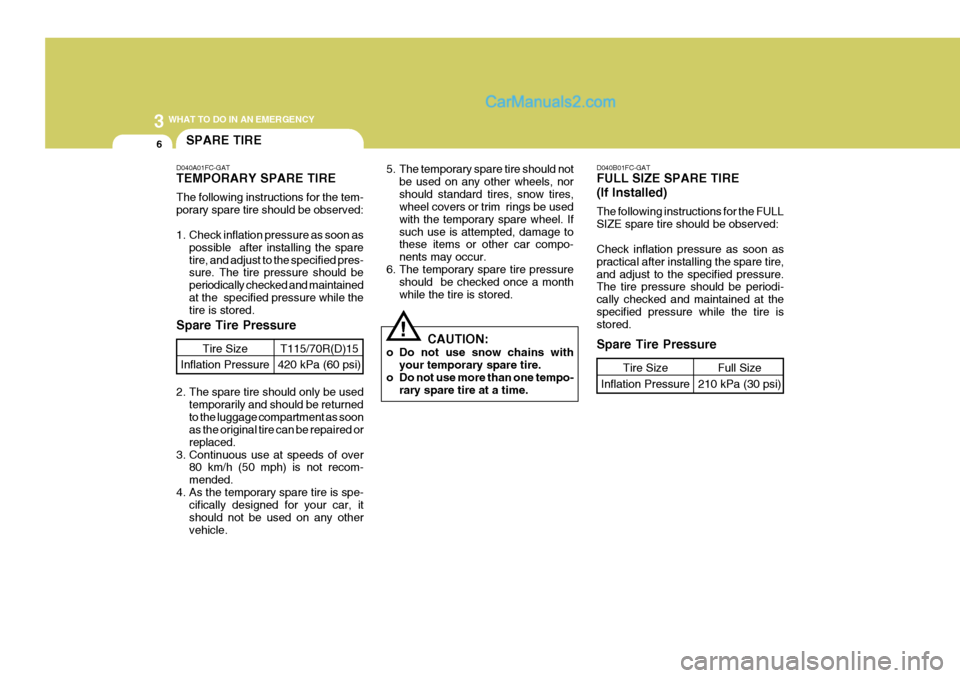
3 WHAT TO DO IN AN EMERGENCY
6SPARE TIRE
D040A01FC-GAT TEMPORARY SPARE TIRE The following instructions for the tem- porary spare tire should be observed:
1. Check inflation pressure as soon as possible after installing the spare tire, and adjust to the specified pres- sure. The tire pressure should be periodically checked and maintainedat the specified pressure while the tire is stored.
Spare Tire Pressure
Tire Size
Inflation PressureT115/70R(D)15
420 kPa (60 psi)
2. The spare tire should only be used temporarily and should be returned to the luggage compartment as soon as the original tire can be repaired or replaced.
3. Continuous use at speeds of over 80 km/h (50 mph) is not recom-mended.
4. As the temporary spare tire is spe- cifically designed for your car, itshould not be used on any othervehicle. 5. The temporary spare tire should not
be used on any other wheels, norshould standard tires, snow tires, wheel covers or trim rings be used with the temporary spare wheel. Ifsuch use is attempted, damage to these items or other car compo- nents may occur.
6. The temporary spare tire pressure should be checked once a monthwhile the tire is stored.
CAUTION:
o Do not use snow chains with your temporary spare tire.
o Do not use more than one tempo- rary spare tire at a time.
! D040B01FC-GAT FULL SIZE SPARE TIRE (If Installed) The following instructions for the FULL SIZE spare tire should be observed: Check inflation pressure as soon as practical after installing the spare tire,and adjust to the specified pressure. The tire pressure should be periodi- cally checked and maintained at thespecified pressure while the tire is stored. Spare Tire Pressure
Tire Size
Inflation PressureFull Size
210 kPa (30 psi)
Page 392 of 407

Vehicle Identification Number (VIN) ............................ 8-2
Engine Number ............................................................ 8-2
Recommended Inflation Pressures ............................. 8-3
Snow Tires ................................................................... 8-4
Tire Chains ................................................................... 8-4
Tire Rotation ................................................................ 8-5
Tire Balancing .............................................................. 8-5
Tire Traction ................................................................. 8-5
When to Replace Tires ................................................ 8-6
Spare Tire and Tools ................................................... 8-6
8
CONSUMER INFORMATION
8
Page 395 of 407
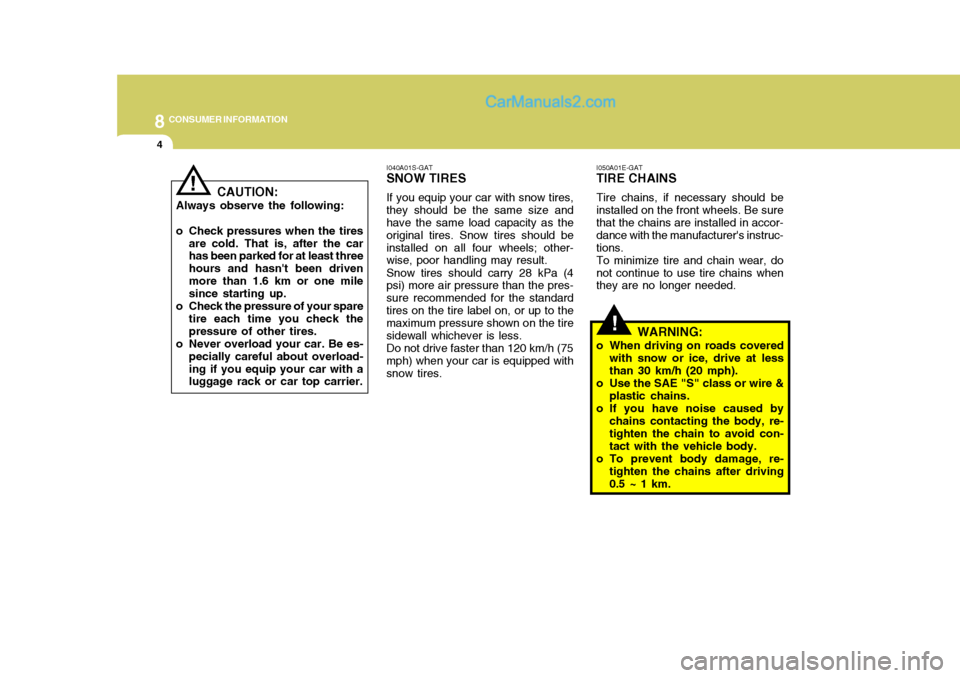
8CONSUMER INFORMATION
4
!
I050A01E-GAT TIRE CHAINS Tire chains, if necessary should be installed on the front wheels. Be sure that the chains are installed in accor- dance with the manufacturer's instruc-tions.To minimize tire and chain wear, donot continue to use tire chains when they are no longer needed.
WARNING:
o When driving on roads covered with snow or ice, drive at less than 30 km/h (20 mph).
o Use the SAE "S" class or wire &
plastic chains.
o If you have noise caused by chains contacting the body, re-tighten the chain to avoid con- tact with the vehicle body.
o To prevent body damage, re- tighten the chains after driving0.5 ~ 1 km.
I040A01S-GAT SNOW TIRES If you equip your car with snow tires, they should be the same size and have the same load capacity as the original tires. Snow tires should beinstalled on all four wheels; other- wise, poor handling may result. Snow tires should carry 28 kPa (4 psi) more air pressure than the pres- sure recommended for the standardtires on the tire label on, or up to the maximum pressure shown on the tire sidewall whichever is less. Do not drive faster than 120 km/h (75 mph) when your car is equipped with snow tires.
CAUTION:
Always observe the following:
o Check pressures when the tires are cold. That is, after the car has been parked for at least three hours and hasn't been drivenmore than 1.6 km or one mile since starting up.
o Check the pressure of your spare tire each time you check the pressure of other tires.
o Never overload your car. Be es- pecially careful about overload-ing if you equip your car with a luggage rack or car top carrier.
!